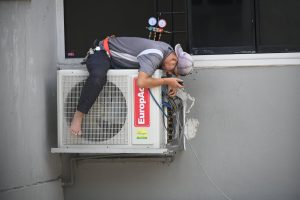The portable air conditioner is a device that helps you cool your room. The dual hoses can cool
a space quickly and efficiently. This makes the whole process faster. Here are some
maintenance tips that will keep your unit in top shape. Keep reading for helpful information. This
article is written by professionals who understand how to maintain a portable air conditioner.
Liza Corsillo used a portable AC to cool her Brooklyn apartment. The machine cooled both the
living and bedroom. The device was just over a foot wide and could fit easily on the kitchen
countertop. She said that she was happy with it. Liza still finds the AC useful, even after a
summer filled with summer vacations. The AC’s dehumidification function kept her room cool
and dry. It also had casters to make it easier to move around.
This smart air conditioner from Honeywell has Alexa compatibility, allowing it to connect to a
smartphone and control the temperature and fan from anywhere. It can be controlled wirelessly
by your voice. This is a great feature for those who don’t want the conditioner touching or
missing important calls. A compact version includes a fan, dehumidifier, and fan. It is especially
useful in the cold months.
Portable air conditioners work similarly to traditional air conditioners. They pull warm air in and
condition it. They use a fan that draws in hot, humid air. The fan then cools it and releases it
back into a room. Portable units use a refrigerant for cooling the air and an evaporator loop to
draw out the moisture. The coils cool the air, extracting water through condensation. Finally,
they pump the cooled air back into the room.
The LG LP1419IVSM air conditioner is one of the most affordable and versatile. This unit is
available in several capacities and offers a dehumidifier and a circulating fan for year-round use.
It also has an inverter-powered compressor that is able to reach the desired temperature in any
weather condition, and is priced much cheaper than its competitors.
A portable air conditioner should have a convenient hose that can be used to remove excess
moisture. Some models have a drain hose that can go outdoors, making them low-maintenance.
Others may require that you empty the hose manually. Portable air conditioners are noisy, so be
sure to choose one with a low noise level. You must remember that the noise level is one the
most important aspects of choosing the unit that will work for you.
You should consider the size of your room when purchasing a portable air conditioner. They
typically cost between $250 and $499 for rooms that measure 200 to 650 square feet. Portable
air conditioners are more expensive in summer months because of the increased demand. So
cooling down in May is likely to be less costly than cooling down in August. If you are
susceptible to fluctuating electricity prices, it may make more sense to use your portable
conditioner at night.
Another important thing to remember is the Btu rating for the portable air conditioner. The Btu
rating will depend on the size of the room, and is an indicator of its cooling capacity. A portable
AC with 7,000 BTU can cool up to 300 square feet. The SereneLife 12,000 BTU air conditioner,
on the other hand, can cool a room up to 450 square feet. It is important that you choose a unit
with a BTU Rating that is appropriate for your room.
You can install portable air conditioners yourself. It includes tools and a venting kit. They are
suitable for students’ accommodations and RVs. If you live in a rented apartment or home, you
can also use a portable air conditioner to cool the place down. The compact design makes it
easy to transport, so it can be taken with you wherever you go. For details on installation, consult
the manufacturer’s manual.
Advanced AC models can be equipped with a self-evaporating function. It draws the moisture
out of the room by using a hose to dump it into the nearest floor drain. You can also use
condensate pumps to remove water and other moisture. You can go eco-friendly by purchasing
a fully self-evaporating unit. These units are made by brands like Avallon, DeLonghi, and others.
The gravity drain or condensate pumps are used to dispose of the water that is collected from
the unit.
